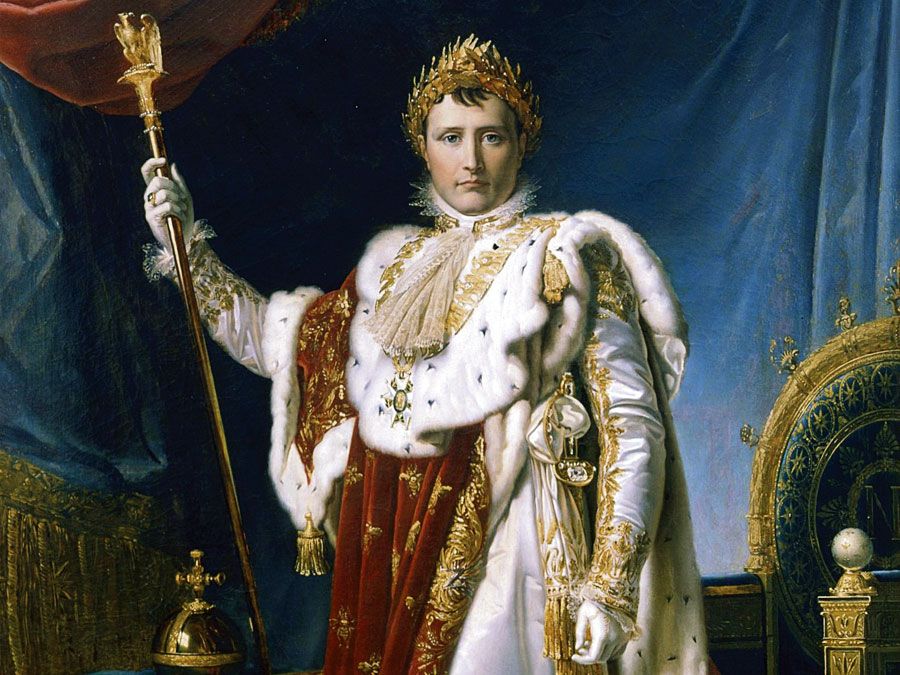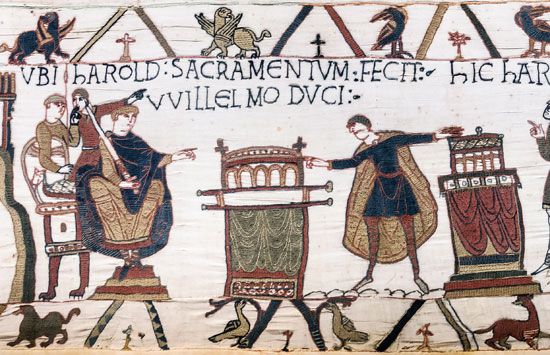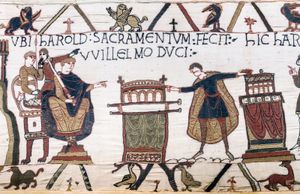Harold II
- Also called:
- Harold Godwineson or Harold Godwinson
- Born:
- c. 1020
- Title / Office:
- king (1066-1066), England
- Notable Family Members:
- father Godwine
- brother Tostig, Earl of Northumbria
News •
Harold II (born c. 1020—died October 14, 1066, near Hastings, Sussex, England) was the last Anglo-Saxon king of England. A strong ruler and a skilled general, he held the crown for nine months in 1066 before he was killed at the Battle of Hastings by Norman invaders under William the Conqueror.
Harold’s mother, Gytha, belonged to a powerful Danish noble family with close connections to Canute, the Danish king of England. Harold’s father, Godwine, earl of Wessex and Kent, was an important supporter of the king. Although an ally of the Anglo-Danish line, Godwine accepted the accession as king of a member of the former English royal family, Edward the Confessor (1042–66), following the death of Canute’s successor. Godwine emerged as the dominant figure in the kingdom early in Edward’s reign, more powerful even than the king himself. About 1044, Godwine obtained for Harold the earldom of East Anglia, Essex, Cambridgeshire, and Huntingdonshire, and in 1045 Edward married Edith, Godwine’s daughter and Harold’s sister.
In 1051, however, Godwine refused to obey a royal command to punish the people of a town friendly to him. Both sides rallied their troops, but Godwine’s rebellion collapsed when powerful nobles supported the king. Godwine and his sons were banished for defying royal authority, and Edward sent his wife to a convent and designated William of Normandy as his heir. (Exiled from 1016 to 1041, Edward had found sanctuary in Normandy. In addition, his mother was a Norman, and he had close connections to Norman churchmen.) In 1052 Harold invaded England and forced the king to restore his father and his family to their previous positions.

Godwine’s restoration was short-lived; he died in 1053. Harold, whose older brother Sweyn had died on pilgrimage the previous year, succeeded to his father’s earldoms, becoming (as his father had been) the dominant figure in the kingdom. His hand was further strengthened in the 1050s by the deaths of Leofric, the earl of Mercia, and other rivals, and by 1057 Harold had obtained earldoms for his three brothers, Tostig, Gyrth, and Leofwine. Harold cultivated good relations with the leading clerics of the kingdom, including Stigand, the bishop of Winchester and archbishop of Canterbury, and was an active patron of various religious houses, most notably the college of canons at Waltham.
Harold faced opposition, however, from Aelfgar, the exiled son and heir of Leofric, who raided Mercia with help from a leading Welsh prince. In retaliation, Harold and Tostig subjugated Wales in 1063. Two years later Harold endured another challenge when the Northumbrians revolted against Tostig, their earl. After killing many of Tostig’s supporters, the rebels offered the earldom to Morcar of Mercia, a member of the family of Leofric, and forced Harold to accept him. Tostig, declared an outlaw by the Northumbrians and abandoned by Harold, fled to Flanders. Harold, however, gained some advantage from this situation. Although he had lost the support of Tostig, he strengthened his position with the Mercians and the Welsh by marrying Morcar’s sister, who had previously been married to a Welsh prince.
Having established himself as the preeminent figure in England by the mid-1060s, Harold most likely expected to ascend the throne after the passing of the childless Edward. His designs, however, were complicated by events in 1064. According to contemporary Norman sources, notably the Bayeux Tapestry, Harold was sent by Edward to Normandy to confirm Duke William as the king’s heir. While en route, Harold was shipwrecked and captured by Guy I of Ponthieu, one of William’s vassals. The duke demanded Harold’s release and may have ransomed him. Harold was warmly welcomed by William and joined him on a military campaign in Brittany. According to the Bayeux Tapestry and other Norman accounts, Harold also swore an oath of fealty to William and promised to protect William’s claim to the English throne.
Despite his promise of the throne to William, Edward from his deathbed designated Harold his heir. On January 6, 1066, the day after Edward’s death, Harold was elected by the English nobility and crowned and anointed king at Winchester Abbey by the archbishop of York.
Harold’s reign, however, was destined to be short and troubled. He was immediately threatened by William and Harald III Hardraade, king of Norway, as well as by Tostig. In May, Harold mobilized his fleet and a peasant army of the south to guard the coast against an expected invasion by William. Meanwhile, Harold was forced to repel Tostig’s raids on the southern and eastern coasts. In September Harald and Tostig invaded in the north, defeating an army at Gate Fulford; marching northward, Harold met them at Stamford Bridge, where he won an overwhelming victory on September 25. Harald and Tostig were killed, and the remnants of their armies quickly left England.
Earlier in September, Harold had been forced to disband his southern army because he had run out of supplies and because his troops had to return to the harvest. Thus, William was free to cross the English Channel unopposed. Finally blessed with favourable winds, William sailed from Normandy on the evening of September 27–28, landed without incident at Pevesney, and set up camp at Hastings. Harold, having just defeated Harald and Tostig, marched southward in all haste, reaching London on October 6. There his army, exhausted by the forced marches across England, rested a few days before setting out to Hastings. In the morning of October 14, however, before Harold had prepared his troops for battle, William’s forces attacked. Despite the surprise, the outcome of the battle was far from certain. William’s efforts to shatter Harold’s shield wall (a formation of troops in which soldiers stand shoulder to shoulder with their shields overlapping) failed at first, and William’s horsemen broke ranks and fled in confusion, with Harold’s army in hot pursuit. But William managed to rally his mounted knights, who turned and cut their pursuers to pieces. Later in the battle, William’s knights feigned two retreats, killing those who chased them. The deaths of Harold—killed by an arrow in the eye, according to the Bayeux Tapestry—and other Anglo-Saxon leaders finally won the day for William. His accession to the English throne as King William I ended the Anglo-Saxon phase of English history.
The manner of Harold’s legendary death, in the medieval view, was the proper fate of perjurers. It is unclear whether Harold really died in this way, however; indeed, legends from the 12th century maintain that he was not killed at Hastings. According to one such tale, Harold spent two years recovering from wounds he received at Hastings before going on pilgrimage in France and England. He returned as an old man and lived as a hermit at Dover and Chester, where he revealed his true identity just before dying. Despite his brief reign, Harold was a key figure in English history and a talented leader in peace and war.



















